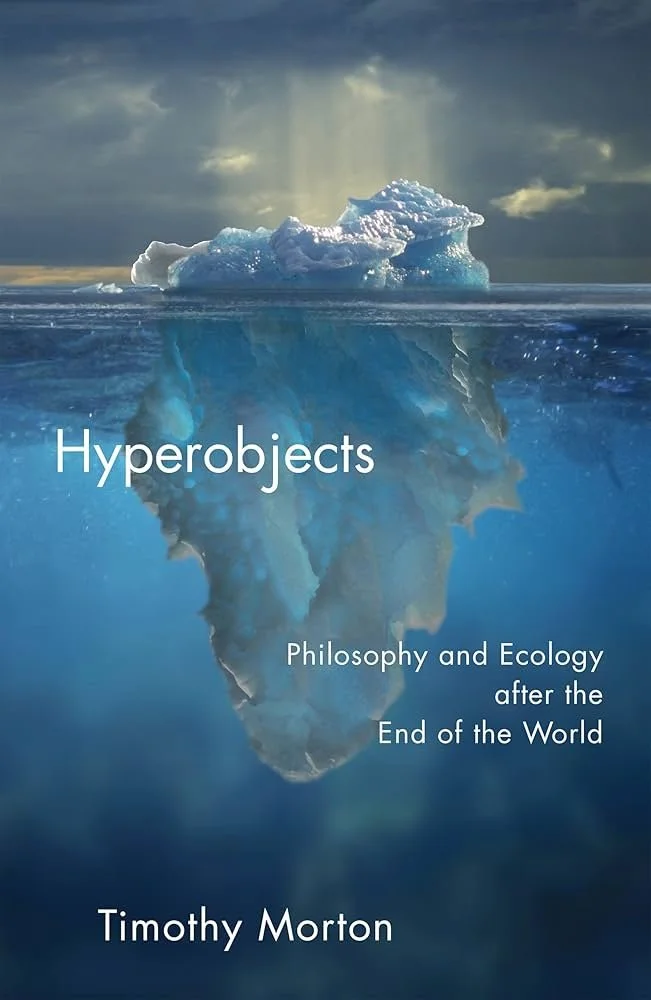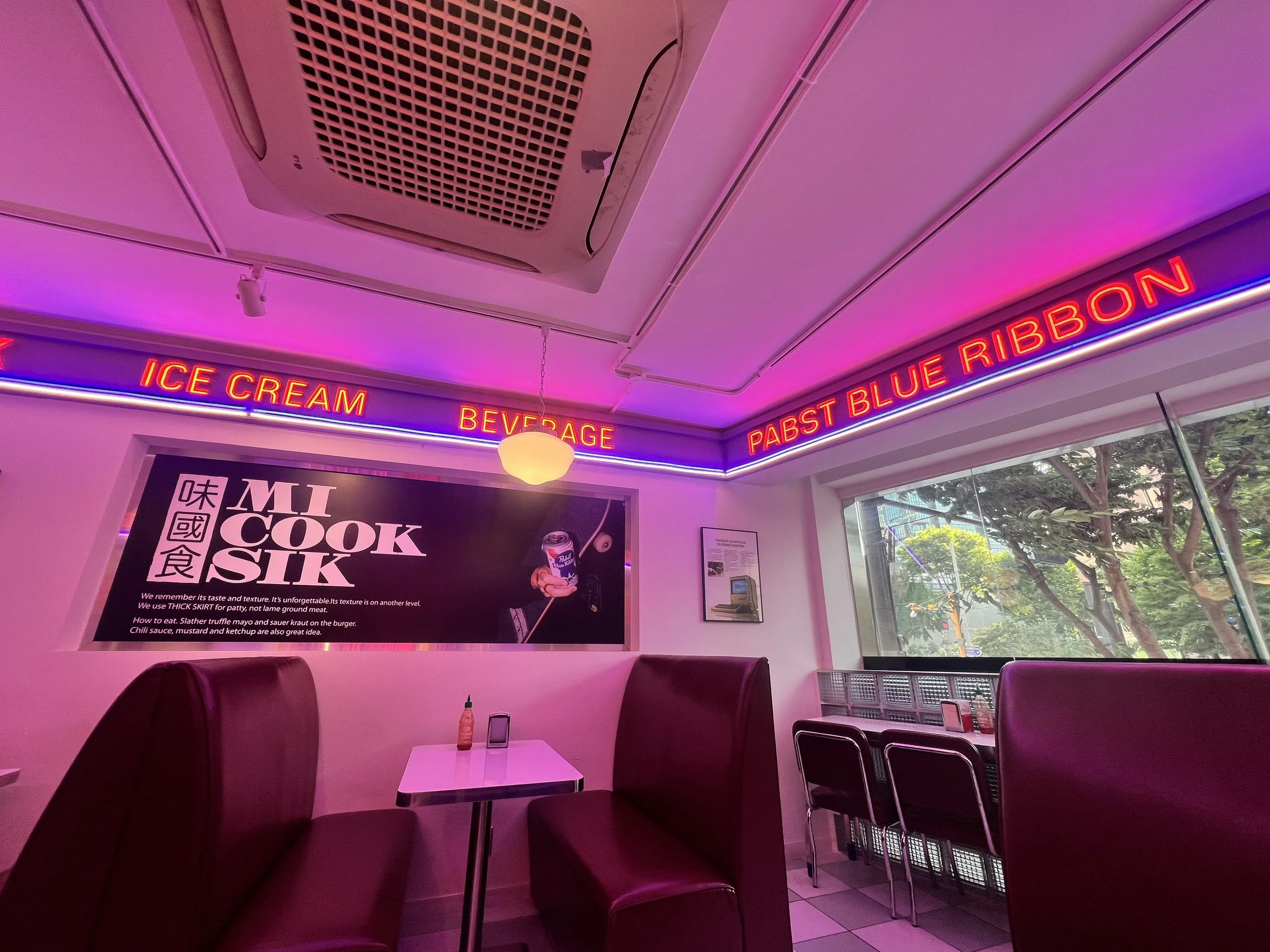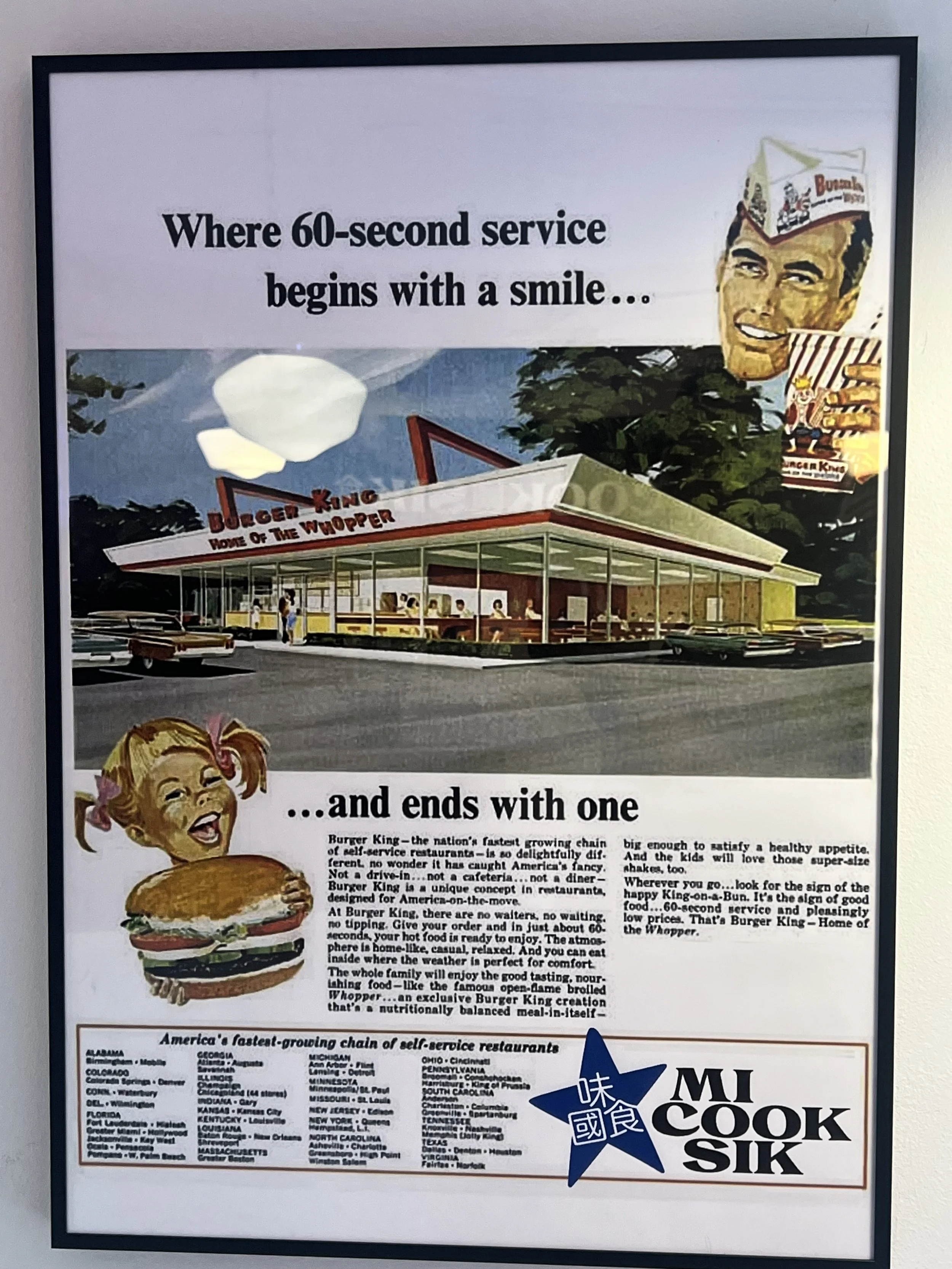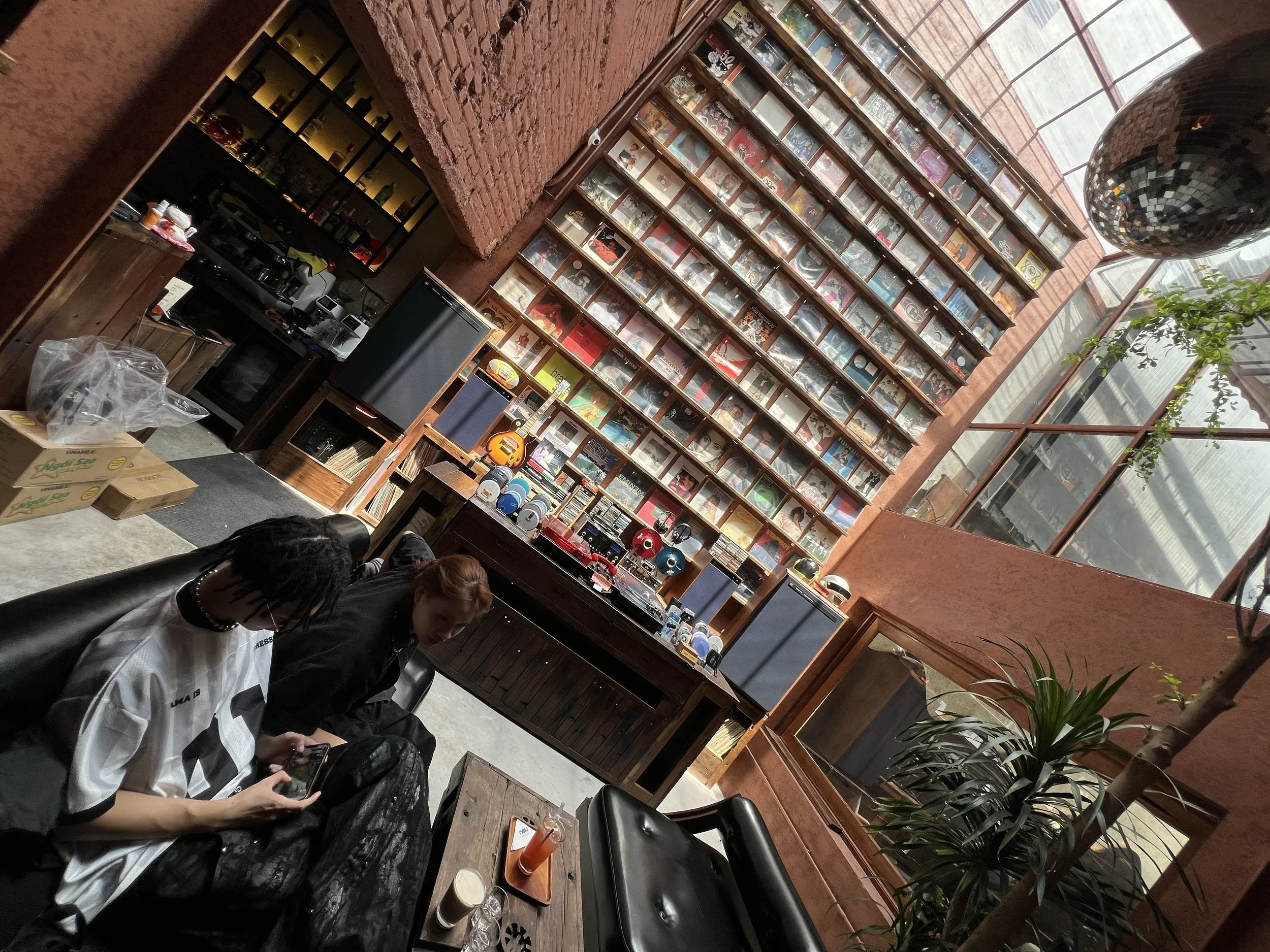Seoul's Hot Places Are the Black Holes You Thought They Were: How They Make Invisible Forces Visible
Climate change. Global capitalism. Digital culture. The forces shaping our lives are too vast to see—until you walk into a Seoul café. How the world's most interface-dense city turns invisible hyperobjects into Instagram-worthy hot places, one converted factory at a time.
Model @vanina_mdl helps us explore a retro arcade in a sleepy part of the Sadang neeighborhood of Seoul that channels the 80s, analog, and notions of retro in a space that’s an “arcade?” An instagrammable selfie studio? It’s actually hard to say.
Try to explain "minimalism" to someone who's never encountered it. You might talk about "less is more." Reduction to essentials. Japanese Zen aesthetics meeting Bauhaus functionality meeting Scandinavian simplicity. Maybe you'd mention Mies van der Rohe, Marie Kondo, or Apple stores. But where does minimalism actually exist? When did it start? Is it Japanese or German or Scandinavian or Californian? Is it white walls, or is it concrete? Is it expensive luxury, or is it anti-materialist philosophy?
Like, how can you simply understand, it, bro?
Minimalism is what philosopher Timothy Morton calls a hyperobject—an entity so vast across time and space that you can't actually point to it or fully comprehend it. It's everywhere and nowhere. A design movement spanning centuries and continents. A philosophical stance. An aesthetic sensibility. An economic class marker. All at once. Too big to see.
Now walk into Café Onion in Seoul's Seongsu-dong neighborhood.
You're standing inside a former 1970s metal factory. Raw concrete walls—actually unfinished plaster in places—catch light streaming through massive industrial windows. The floor still shows traces of yellow paint from another era. Mini faded blue tiles peek through in corners. Where doors once opened, bricks have been shoved in haphazardly to seal the space. Ten-meter ceilings expose rusted steel beams overhead. Everything is deliberately unfinished. Everything is perfectly complete.
The hyperobject—this vast, abstract, impossible-to-pin-down thing called "minimalism"—suddenly becomes as concrete as these walls. As tangible as the Pandoro bread (a small mountain covered in powdered sugar) sitting on the counter. As everyday as the line of twenty-somethings waiting to order their morning Einspänner.
And here's what makes it remarkable: This isn't a museum. This isn't a luxury boutique. This is where Seoul shows up to live. Students camp out for six-hour study sessions with a single Americano. Couples meet for dates. Freelancers take work calls from the rooftop terrace. The hyperobject gets domesticated. Made useful. Made Korean.
But wait—there's a twist. Research shows that what gets called "Korean minimalism" in spaces like Café Onion actually contains design elements from Japanese minimalism, Scandinavian functionality, and American industrial aesthetics—all filtered through Korean spatial logic and repackaged as something entirely new. The hyperobject doesn't just get made visible in Seoul. It gets remixed. Translated. And then Vietnamese consumers open cafés inspired by what they think is "Korean" style, which is actually this transcontinental aesthetic package that Seoul compressed and rebranded.
This is Seoul's superpower: turning hyperobjects into hot places. Making the invisible viscerally real. And doing it not once or twice, but 18,000+ times—once for every café in the city.
The Hyperobject Problem
Here's the fundamental challenge of living in the 21st century: the most important forces shaping our lives are entities we can't see, touch, or fully comprehend.
Timothy Morton, a philosopher at Rice University, coined the term "hyperobjects" to describe these massive entities that are "massively distributed in time and space relative to humans." Climate change is a hyperobject. You can't point to climate change—you can only point to manifestations of it: a melting glacier here, a hurricane there, a heat wave in Seoul in July. But climate change itself? It's too big, too distributed across space and time, too entangled with everything else to ever be directly perceived.
Global capitalism is a hyperobject. So is the internet. So is mass culture. And here's the kicker that Morton argues: cities themselves are hyperobjects. Seoul isn't just a collection of buildings you can see. It's a massive entity distributed across time (from Joseon dynasty hanoks to tomorrow's construction projects), across space (from underground shopping malls to rooftop gardens), across millions of human and non-human actors (people, infrastructure, capital flows, cultural trends) all knotted together in ways too complex for any single person to grasp.
The question becomes: how do you live inside something you can't see or understand? How do you make decisions about forces that exceed your ability to perceive them?
The answer—at least in Seoul—is urban interfaces.
Translation Machines for the Incomprehensible
Think of your smartphone's interface. You can't see the millions of lines of code running inside. You can't perceive the electromagnetic signals bouncing between your phone and cell towers. You can't directly access the vast server farms storing your data. But you don't need to. The interface—that touchscreen—translates all that invisible complexity into something you can interact with: icons, swipes, taps.
Urban interfaces work exactly the same way. They're the zones where massive, invisible forces—those hyperobjects—suddenly become visible, touchable, actionable in daily life.
Kim Dovey and Stephen Wood, researchers who've spent years studying urban interfaces, define them as "diagrams of connectivity that enable the creation, production and reproduction of ideas, goods, services and identities." But that's academic-speak. Here's what they really mean: urban interfaces are translation machines. They take abstract global forces and turn them into concrete local experiences.
Consider what's happening right now in Dongdaemun. There's a fashion building—you can walk into it, touch its walls, smell the fabric—where three complete economic systems occupy the same physical space on different time scales. From 11 PM to 7 AM, it's a wholesale market. Korean fashion buyers in practical clothes negotiate bulk orders with suppliers. Boxes everywhere. Serious business. The circulatory system of the Korean fashion industry, pumping products across Asia.
Come back at 2 PM. Same building. Same floor. Completely different world. The space has transformed into gleaming retail boutiques. Teenagers browse racks of the same clothes that were being sold in bulk just hours earlier. Different music. Different lighting. Different people. Same space.
Go down to the basement. It's 24/7 there—sewing machines running constantly, producing the clothes that will be sold wholesale tonight and retail tomorrow.
This is what Morton calls the "viscosity" of hyperobjects—they stick to you, they're everywhere, you can't escape them. But normally you can't see them. Dongdaemun makes the invisible circulation of global capital literally visible. Production. Wholesale. Retail. All compressed into one building where you can watch global capitalism breathe in and out.
The Density Formula
Here's where Seoul gets really interesting. It's not enough to have one or two places where hyperobjects become visible. Seoul has engineered an entire ecosystem of urban interfaces, and they've achieved a density that's unprecedented globally.
Researchers studying Seoul's "hot places"—the neighborhoods that become internationally famous, that tourists flock to, that define Seoul's global aesthetic influence—discovered something remarkable. These hot places aren't hot because they have one amazing building or one unique feature. They're hot because they pack multiple interface types into remarkably small spaces.
Seongsu-dong, currently Seoul's hottest neighborhood, contains 8-9 different interface types compressed into a walkable area. There's the industrial heritage base (those 1970s factories being converted). There's the selfie studio infrastructure (Instagram-optimized photo zones). There's the luxury brand presence (Dior, Chanel, Hermès operating pop-ups). There's the constant temporal transformation (40-60 popup stores appearing and disappearing per week). There's the underground hidden venues requiring insider knowledge. There's the traditional residential areas it borders.
Each interface type makes a different hyperobject visible. The industrial heritage makes visible the transition from manufacturing to creative economy. The luxury popups make visible global brand strategies and consumer aspiration. The constant churn of temporary spaces makes visible the acceleration of cultural production and the attention economy. The hidden venues make visible the sociology of insider knowledge and cultural capital.
But here's the mathematical insight: it's not just variety, it's density. Researchers calculated that Ikseon-dong, a neighborhood of traditional hanok buildings that's become a hot place, achieves interface density that's 4,000 times greater per square meter than even Seongsu. In a single 80-square-meter hanok building, you might find: a century-old residential structure (traditional architecture), a modern café (industrial-chic aesthetics), a Thai restaurant with a swimming pool (international fusion), and a BB gun shooting range (recreational entertainment)—all compressed into less space than a tennis court.
This isn't just "dense." This is approaching what physicists would call a singularity—a point where normal rules break down because too much is compressed into too small a space.
Where Hyperobjects Become Instagram-Worthy
Let's make this concrete. Walk through Sewoon Sangga, a kilometer-long brutalist building in central Seoul that was built in 1968.
Ground floor: You're in 1975. Cluttered electronics vendors sit at workbenches unchanged for 50 years, surrounded by the smell of metal shavings and solder. Old men in work clothes repair circuit boards. This interface makes visible the persistence of analog repair culture, the resistance to planned obsolescence, the skilled labor that global consumer electronics depend on.
Take the elevator up two floors: You're in 2024. A minimalist café called London Cake serves flat whites to laptop workers. Craft coffee smells mix with—wait, you can still smell the metal shavings from downstairs. This interface makes visible the collision between manual labor and creative-class work, between industrial production and service economy, between blue-collar and white-collar Seoul.
Climb three more floors: Desolate emptiness. Natural light streams through abandoned arcade spaces frozen in time. This interface makes visible economic abandonment, the creative destruction of capitalism, the half-life of modernist urban planning dreams.
Take the stairs to the rooftop: Suddenly you're in an urban garden hosting cultural events. This interface makes visible urban ecological adaptation, public space creation, the rooftop as Seoul's secret geography.
One building. Five decades. Eight floors. Multiple hyperobjects—deindustrialization, gentrification, urban ecology, the creative economy, the persistence of craft—all made simultaneously visible and experienceable. You're not reading about these forces in a sociology textbook. You're walking through them.
The 45.5% Solution
Not a cafe, per se, but a trendy burger place in Seoul Forest. But it is a place that is a convergence point and interface for all kinds of international ideas, from old-fashioned Americana vibes to the fetishization of working Class consumer symbols, like the Pabst Blue Ribbon beer, which is an even deeper cut of Americana retro aesthetics. As well as an older fashioned, Korean kind of retro aesthetic in terms of the usage of SIno-Korean Chinese characters, topped off by the cheeky punnery in the way they are pronounced: the characters sound out as “mi cook shik” which can be translated as “American style” in one misusage (the Chinese character used in Korea for “American” mi is the character and homonym for “delicious”), or in a funny way as “the delicious way I cook.” There’s a lot happening and coming together here, especially in combination wwith other signage in the place.
But here's what really matters: none of this is accidental. None of this is just aesthetic.
A 2023 study found that 45.5% of Korean café customers prioritize interior design over beverage quality. Read that again. Aesthetics trump taste by nearly two-to-one. This isn't superficiality—this is sophisticated spatial intelligence.
When young Koreans say they're choosing a café based on interior design, what they're really saying is: "I need this space to make certain invisible forces visible and manageable for me." They're selecting interfaces based on which hyperobjects they need to engage with that day.
Another poster in the Mi Cook Shik restaurant, which plays even more on Americana aesthetics, but which possibly converge with hand-drawn Korean characters that would be familiar to Koreans at the time ()and which have now become repopularizedin the revival of the Younghee and Chulsoo in recent global media such as Squid Game. The globalization of Korean culture has made this piece of Americana even more legible to the young Koreans this kind of interior design is aimed at, even as that glabalization of Korea itself has exposed Koreans more, in the first place, to these specific aesthetics markers from far across the globe. This restaurant makes all of the converege and become powerful markers of cool…and drivers of consumption.
Need to feel connected to global cosmopolitanism? Pick the Scandinavian-minimalist café that makes global design trends tangible. Need to feel anchored in local tradition? Pick the hanok café that makes Korean heritage touchable. Need to feel part of the creative economy? Pick the converted factory space that makes post-industrial transformation your aesthetic.
And because Seoul's housing is crushingly expensive—average Seoul apartment costs $850,000, often for just 25 square meters—these cafés aren't just aesthetic choices. They're essential infrastructure. They're where life happens. The hyperobjects aren't just made visible; they're made livable.
Professor Lee Eun-hee from Inha University explains it perfectly: "Cafes serve as a haven of social comfort for individuals living alone, compensating for the absence of direct interpersonal interactions. Moreover, in the presence of other people, these cafe-goers create their own enclosed physical and psychological space."
The café becomes what sociologists call a "third place"—separate from home and work—where hyperobjects get translated into manageable daily experience. You can't afford to buy an apartment that embodies your relationship to global design trends. But you can buy a 4,500-won Americano and inhabit that relationship for six hours.
The Appropriation-Rebranding Feedback Loop
The Nậu Café & Cassette Workshop — which a local coffee shop owner and others told us was the most "Korean café" in Hanoi. Look closer at the walls: American jazz records, classic rock, 1990s hip-hop albums. The vintage audio equipment? Pure Americana. When we asked the staff about the Korean influence, they looked puzzled. "This place isn't Korean," they told us directly. So why did everyone call it Korean? It turns out Vietnamese consumers aren't confused about cultural origins—they're demonstrating something much more sophisticated. They understand that "Korean coolness" has become a delivery system for global aesthetics, and they're actively curating those global elements according to their own cultural logic, which is accepting the “Korea”-shaped packagethat is itself a curated delivery vehicle of its own. The space maintains traditional Vietnamese social patterns (notice the low seating and community-friendly layout) while adopting what locals interpret as “Korean” (modern) style. This café reveals how culture actually travels: not as pure transmission from one A to B, but as creative local translation of global flows.
Now for the really wild part.
Researchers studying Korean cultural influence in Vietnam made a surprising discovery. Multiple Hanoi cafés described as having "Korean style" featured design elements that actually came from Scandinavian minimalism or American hip-hop aesthetics. But these elements had been filtered through Korean cultural packaging—through places like Café Onion, through Seoul's interface ecosystem—and were genuinely perceived as Korean by Vietnamese consumers.
This creates what researchers call an "appropriation-rebranding feedback loop":
Seoul appropriates American hip-hop aesthetics, vintage nostalgia, and other cultural elements
Seoul integrates them into distinctively Korean spatial packages (those 8-9 interface types compressed together)
Seoul exports these hybrid aesthetics globally under "Korean" cultural branding
Global audiences read the appropriated elements as "Korean" rather than recognizing original cultural sources
Seoul reinforces this interpretation—the appropriated aesthetics become "authentically Korean"
The hyperobject—call it "global aesthetic culture"—gets compressed, remixed, and rebranded so successfully that the remix becomes the original. Korean cultural branding becomes so dominant it can absorb and re-export other cultures' elements under Korean identity.
Vietnamese café owners aren't copying Scandinavian design. They're copying Korean cafés that copied Scandinavian design. The interface has become the thing itself.
Black Holes and Hot Places
Which brings us back to the physics metaphor.
In astrophysics, a black hole is a region where gravity is so strong that it warps spacetime itself. Normal rules break down. Matter and energy get compressed to impossible densities. Nothing can escape, not even light.
Seoul's hot places work the same way. They're regions where interface density is so high that normal urban rules break down. Global forces that usually remain invisible get compressed to the point where they become inescapable, tangible, photographable.
Seongsu-dong with its 40-60 popup stores per week? That's not just commercial activity—that's the attention economy and brand competition compressed so intensely you can watch it evolve in real-time. The neighborhood becomes a particle accelerator for cultural trends.
Ikseon-dong with 6 interface types packed into 80 square meters? That's not just a dense neighborhood—that's where the hyperobject of "tradition vs. modernity" gets compressed so intensely it approaches singularity. You're not choosing between old and new. You're inhabiting a space where old-and-new-simultaneously becomes its own category.
And just like black holes, these hot places have enormous gravitational pull. They don't just reflect trends—they create them. They don't just respond to global culture—they warp it.
The Interface Ecosystem
All the coffee shops in the Seongsu/Seoul Forest areas. That’s a LOT of coffee.
Here's what makes Seoul's achievement unique: it's not about individual buildings or even individual neighborhoods. It's about the ecosystem.
Seoul has 100,729 coffee shops. Eighteen thousand just in the city proper. That's approximately one café for every 555 people. Each one functions as an interface, making different hyperobjects visible and manageable. Each one contributes to the ecosystem.
Some make global capitalism visible (the luxury café with $8 lattes). Some make traditional culture visible (the hanok café with ondol heating beneath the espresso machine). Some make industrial heritage visible (the warehouse conversion). Some make digital culture visible (the selfie studio café with designated photo zones). Some make international culture visible (the café serving Einspänner, a Viennese coffee tradition, in a former Korean metal factory).
But they don't work in isolation. They work as a system. The hot places emerge where multiple interface types cluster together, where you can move from one translation of reality to another within a five-minute walk.
This is what urban theorist Bing Bu calls "interface ecosystem engineering." Seoul hasn't just created good individual spaces. Seoul has created a network of spaces that, collectively, make the 21st century's essential hyperobjects—globalization, cultural hybridization, digital transformation, the attention economy, compressed modernity—not just visible but navigable.
The Hidden Curriculum
There's an educational dimension to this that's easy to miss.
When young Koreans spend six hours in a café, studying for exams or working on freelance projects, they're not just using the space. They're learning to read it. They're developing what we might call interface literacy—the ability to recognize which hyperobjects are being made visible, how they're being translated, what the implications are.
This is why 45.5% prioritize design over taste. The design isn't decoration. The design is information. It's telling you which forces you're engaging with, which version of reality you're inhabiting, which identity you're performing.
A student choosing between Café Onion (industrial-minimalist) and a hanok café (traditional-modern) isn't choosing between coffee shops. They're choosing between different ways of understanding their relationship to Korean modernity, global aesthetics, cultural tradition. They're choosing which hyperobjects to engage with that day.
Over time, this develops into sophisticated cultural intelligence. You learn to read spaces quickly. You learn to navigate between different reality-translations. You learn to see the hyperobjects that other people can't see because they haven't developed the literacy.
This might be Seoul's real export: not just K-pop or K-beauty or K-fashion, but K-interface literacy—a sophisticated ability to read, navigate, and create spaces that translate complex global forces into manageable local experiences.
The Ultimate Interface
In this singlular space, all kinds of urban interfaces converge, along with being a physical nexus where above and below-ground merge, the public and private spaces of events at the DDP mix, a Vietnamese model-influencer can encounter everyday people, a Hera kiosk can be placed on the ramp where people are doing dtreet fashion, while Korean flags marking the area as Koreaspace blow in the wind above. The combinations and collisions are endless.
Let's end with the most dramatic example: the Dongdaemun Design Plaza.
When Zaha Hadid's "spaceship" building opened in 2014, critics dismissed it as an expensive eyesore, alien to Seoul's urban fabric. But Hadid had embedded something revolutionary in the building's design: what she called parametricism—architecture that adapts to users rather than prescribing how space should be used.
The DDP has five different entrances at different elevations. You can enter from the subway below. You can enter from a bridge above. You can enter from multiple side tunnels. There's no single "front door," no hierarchical entry sequence. The building simultaneously functions as architecture and as landscape, as roof and as plaza.
What Hadid created—perhaps without fully realizing it—was an interface singularity. A space where so many urban systems collapse together that the building itself becomes a hyperobject you can walk through.
The DDP sits in Dongdaemun, where those fashion buildings operate on 24-hour cycles of wholesale and retail. It's connected to Seoul's subway system. It hosts Seoul Fashion Week. It contains a design museum, a history museum (built over Joseon dynasty ruins discovered during construction), a design marketplace open 24/7, event spaces, and a massive roof garden.
But here's what makes it a true interface singularity: the building was designed for fashion shows, but what happened instead is that street fashion participants—called paepi—discovered that the metallic ramp leading to the entrance was far more photogenic than any runway inside. Unlike the exclusive shows inside, anyone could access the ramp.
Within months, the unofficial street fashion display on the DDP ramp was drawing more international media attention than the official fashion shows. Vogue, GQ, The New York Times started covering Seoul Fashion Week primarily to photograph the street fashion outside, barely mentioning the runway shows inside.
The interface—the ramp, the public access, the Instagram-optimized metallic surface—became more influential than the content it was designed to serve. The translation became more important than the thing being translated.
This is the ultimate expression of Seoul's superpower: creating spaces where the interface itself becomes the hyperobject, where the translation mechanism becomes what gets transmitted globally.
Learning to See Hyperobjects
Once you understand this framework, you can't unsee it. Seoul stops looking like a collection of trendy neighborhoods and starts looking like what it really is: a massive, distributed hyperobject translation system.
Those 18,000 cafés? Translation nodes. Those hot places? Compression zones where multiple hyperobjects become simultaneously visible. Those converted factories? Sites where economic transformation becomes architectural. Those hanok villages? Zones where tradition vs. modernity becomes an experienceable paradox rather than an abstract tension.
And this matters beyond Seoul. Because the forces Seoul has learned to translate—globalization, cultural hybridization, the attention economy, digital transformation, compressed modernity—these are the hyperobjects everyone in the 21st century needs to navigate.
Other cities are starting to copy Seoul's model. Vietnamese cities, Chinese cities, even some Western cities are trying to replicate the interface density. But they're often just copying the aesthetics—the concrete walls, the industrial conversions, the minimalist furniture—without understanding the system.
Seoul's achievement isn't creating pretty spaces. Seoul's achievement is creating an ecosystem of interfaces that collectively make the unmappable mappable, the invisible visible, the incomprehensible graspable.
In a century defined by hyperobjects—climate change too big to see, capitalism too complex to understand, cultural change too fast to track—Seoul has pioneered a model for how humans might actually navigate these forces.
Not by trying to comprehend the hyperobjects directly. That's impossible. But by creating dense networks of spaces that translate them, compress them, make them actionable at human scale.
By turning black holes into hot places. By making the invisible Instagram-worthy. By engineering interfaces that don't just show you the future—they let you live in it, one 4,500-won Americano at a time.






